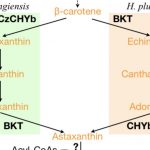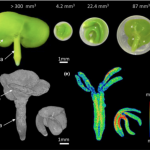Plant Science Research Weekly: September 4, 2020
Review. Imaging flowers: a guide to current microscopy and tomography techniques to study flower development
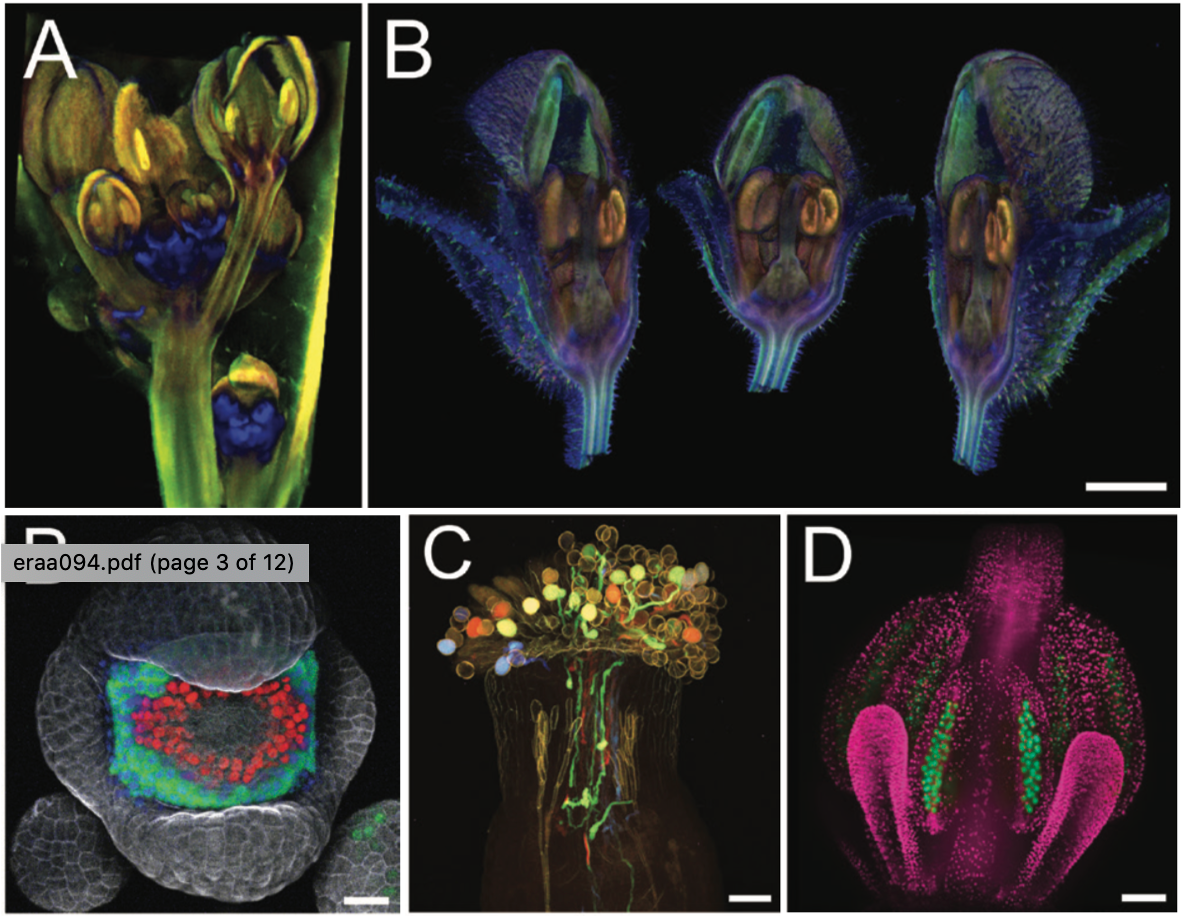
Flowers bear the reproductive organs and determine the reproductive success of plants by producing fruits and seeds. Flowers usually include four whorls of organs: sepals, petals, stamen and carpel. In this review, Prunet and Duncan discuss various microscopic and tomographic techniques to image flower organs with different levels of resolution and at different depths. They focus on the point-scanning confocal, spinning disc confocal and two-photon microscopy and their pros and cons, including the lateral and axial resolution, imaging depth, live imaging and fluorescent protein compatibility. The authors also describe high-resolution microscopy techniques like structured illumination microscopy (SIM), stimulated emission depletion microscopy (STED), light sheet microscopy, and single molecule localization microscopy (SMLM) techniques which give high resolution images at the cost of speed. Optical microscopy cannot provide accurate 3D deep tissue images, but this problem can be circumvented by tomography. Tomography techniques include optical projection tomography (OPT), macro-OPT, X-ray microscopy (XRM), X-ray tomography (XRT). These methods acquire 3D images at a fast speed but at the cost of cellular resolution. Finally, the authors discuss the various reporters and sensors developed recently for better quantification of gene activity and hormone signaling, and the software to analyze the huge datasets created using these techniques. (Summary by Vijaya Battula @Vijaya_Batthula). J. Exp. Bot. 10.1093/jxb/eraa094
Review: Compartmentalization drives the evolution of symbiotic cooperation
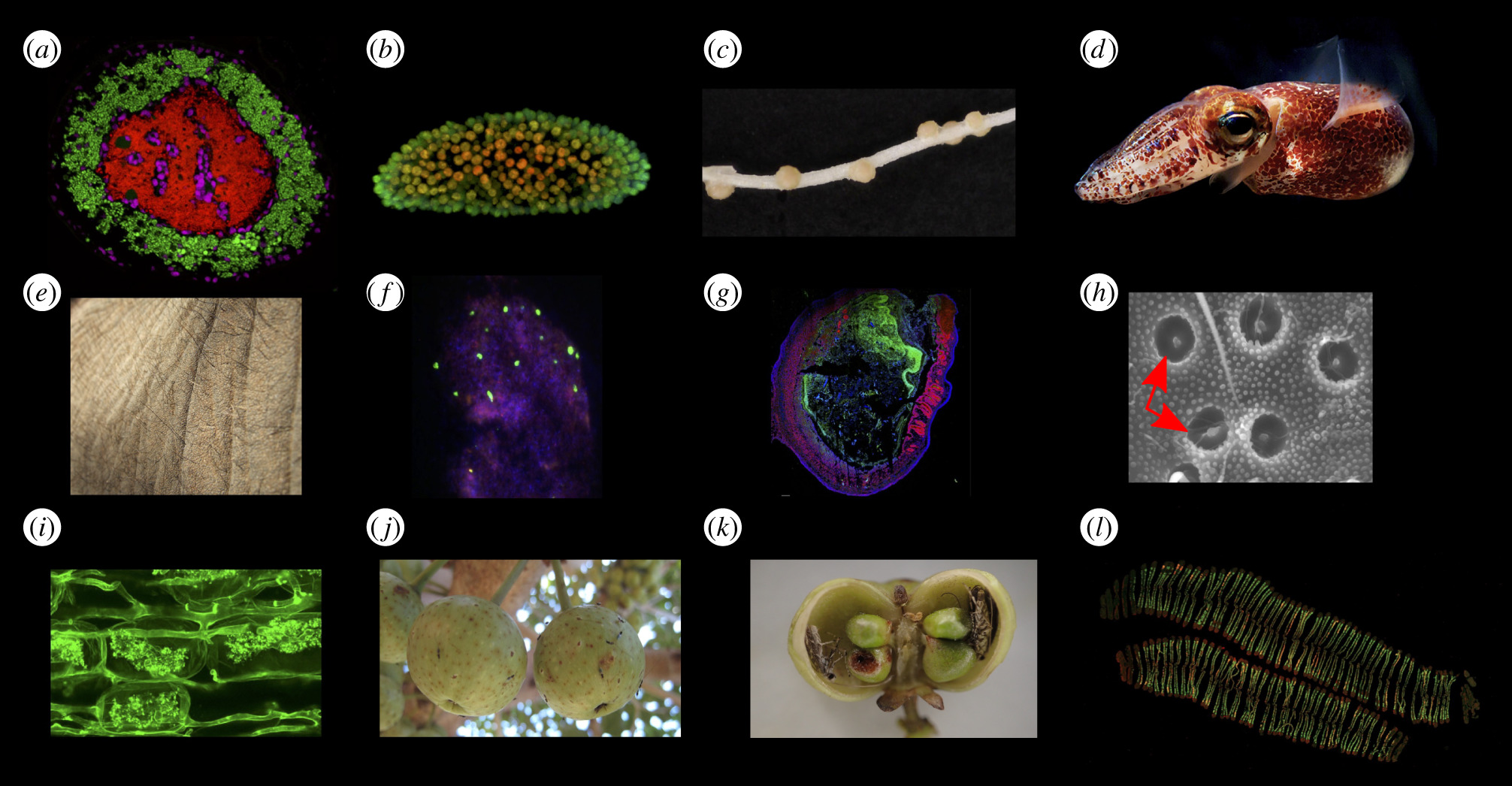
Many plants take advantage of microbial symbionts to boost their nutrient uptake, with classic examples provided by mycorrhizal fungi and the legume/Rhizobia partnership. Similar symbiotic partners are found in other domains of life, including the coral/dinoflagellate symbiosis, and the symbiosis between many insects or other animals and their gut microbiota. Chomicki et al. address all these symbioses and ask the question: how does the host control the guest, to prevent the beneficial relationship from tipping into parasitism? The authors observe that in most of these successful partnerships, the symbiont is sequestered into some sort of compartment, which allows the host to both selectively filter their entry, and to control the growth and reproduction of the symbiont. This interesting review is a useful perspective on the evolution and ecology of host/symbiotic interactions and benefits from its broad, multi-kingdom perspective. (Summary by Mary Williams @PlantTeaching) Proc. Roy. Soc. 10.1098/rstb.2019.0602
Plastid stress signaling alters cell cycle progression
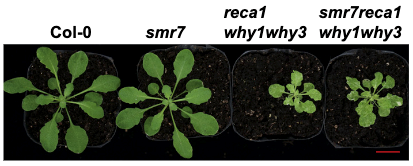
The chloroplast is in constant communication with the nucleus via so-called retrograde signaling. This signaling, which can take many molecular forms, is important for maintaining chloroplast function. In this paper by Duan et al. we learn that interfering with plastid DNA replication, either through mutation of plastid-targeted replication factors, or by specific drugs, leads to broad changes in leaf cell number, size and nuclear DNA content. The authors suggest that these changes are signaled through reactive oxygen species (ROS) generated as a consequence of plastid malfunction. They further propose the transcriptional regulator SOG1 as a down-stream effector of the ROS signal, which may modulate cell proliferation via altered gene expression. Although the study leaves somewhat open the relevance of plastid DNA damage per se, it provides an example of how the nuclear DNA replication cycle is sensitive to the state of the chloroplast. Further research is needed to work out the signaling pathway involved. (Summary by Frej Tulin @FrejTulin) Cell Reports 10.1016/j.celrep.2020.108019
Multiple QTL mapping in autopolyploids: A random-effect model approach with application in a hexaploid sweetpotato full-sib population
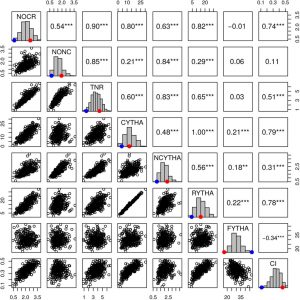 Gene mapping and QTL identification for the improvement of important traits have not been fully explored in an autopolyploid species like sweetpotatoes (2n=6x=90) due to its genetic complexity. Most sweet potato QTL mapping efforts have relied on models used for diploid species, leading to low density maps with restrictions on the statistical power for QTL detection. In tetraploids and hexaploids, the fixed-effect interval mapping (FEIM) model has also enabled easier QTL detection. Here, G. da Silva Pereira et al. explored the random-effect model (REMIM) approach and mapped multiple QTLs for yield-related traits from a sweetpotato biparental population. They compared the number of QTLs detected by the FEIM and REMIM models, and found both to be similar for yield-related traits such as storage root yield and quality and resistance to biotic and abiotic stresses, however detection power for LOD threshold was higher in the REMIM. In addition, the REMIM model was able to detect the heritability and correlation of different parental populations under varying environment and increasingly difficult scenarios. This QTL mapping method will breeding in sweetpotatoes and other autopolyploid species. (Summary by Modesta Abugu @Modestannedi) Genetics 10.1534/genetics.120.303080
Gene mapping and QTL identification for the improvement of important traits have not been fully explored in an autopolyploid species like sweetpotatoes (2n=6x=90) due to its genetic complexity. Most sweet potato QTL mapping efforts have relied on models used for diploid species, leading to low density maps with restrictions on the statistical power for QTL detection. In tetraploids and hexaploids, the fixed-effect interval mapping (FEIM) model has also enabled easier QTL detection. Here, G. da Silva Pereira et al. explored the random-effect model (REMIM) approach and mapped multiple QTLs for yield-related traits from a sweetpotato biparental population. They compared the number of QTLs detected by the FEIM and REMIM models, and found both to be similar for yield-related traits such as storage root yield and quality and resistance to biotic and abiotic stresses, however detection power for LOD threshold was higher in the REMIM. In addition, the REMIM model was able to detect the heritability and correlation of different parental populations under varying environment and increasingly difficult scenarios. This QTL mapping method will breeding in sweetpotatoes and other autopolyploid species. (Summary by Modesta Abugu @Modestannedi) Genetics 10.1534/genetics.120.303080
Molecular regulation of meristem development in liverworts
 Plants grow through meristems, pools of undifferentiated cells that produce and develop into all varieties of cell types. Flowering plants such as Arabidopsis regulate meristematic cell division through CLAVATA3/EMBRYOSURROUNDING REGION-related (CLE) peptide signaling, but the molecular mechanisms in which this regulation is performed in land plant ancestors have yet to be fully uncovered. Hirakawa et al. further deciphered these mechanisms in the liverwort Marchantia polymorpha. Relative to flowering plants, the M. polymorpha genome contains a minimal set of CLE genes, and the function of MpCLE2, the sole orthologue of CLAVATA3, has been unknown. The authors revealed that enhanced MpCLE2 peptide signaling induced larger apical notches and an increased number of meristematic regions, which led to multichotomous branching and dwarfed, convoluted thalli. Further experiments, using genetics and marker lines, demonstrate that signaling between MpCLE2 and MpCLV1 (a receptor protein for the MpCLE2 peptide) “acts as a positive regulator of stem cell maintenance in shoot meristems of the M. polymorpha gametophyte body.” Moreover, this signaling is independent of established downstream CLE targets in flowering plants. Such work opens the door for discovering how plants regulate the growth and development of their meristems, a vital pathway that allowed plants to colonize land. (Summary by Benjamin Jin) Curr. Biol. 10.1016/j.cub.2020.07.016
Plants grow through meristems, pools of undifferentiated cells that produce and develop into all varieties of cell types. Flowering plants such as Arabidopsis regulate meristematic cell division through CLAVATA3/EMBRYOSURROUNDING REGION-related (CLE) peptide signaling, but the molecular mechanisms in which this regulation is performed in land plant ancestors have yet to be fully uncovered. Hirakawa et al. further deciphered these mechanisms in the liverwort Marchantia polymorpha. Relative to flowering plants, the M. polymorpha genome contains a minimal set of CLE genes, and the function of MpCLE2, the sole orthologue of CLAVATA3, has been unknown. The authors revealed that enhanced MpCLE2 peptide signaling induced larger apical notches and an increased number of meristematic regions, which led to multichotomous branching and dwarfed, convoluted thalli. Further experiments, using genetics and marker lines, demonstrate that signaling between MpCLE2 and MpCLV1 (a receptor protein for the MpCLE2 peptide) “acts as a positive regulator of stem cell maintenance in shoot meristems of the M. polymorpha gametophyte body.” Moreover, this signaling is independent of established downstream CLE targets in flowering plants. Such work opens the door for discovering how plants regulate the growth and development of their meristems, a vital pathway that allowed plants to colonize land. (Summary by Benjamin Jin) Curr. Biol. 10.1016/j.cub.2020.07.016
The karrikin signaling regulator SMAX1 controls Lotus japonicus root and root hair development by suppressing ethylene biosynthesis

KARRIKIN INSENSITIVE 2 (KAI2) and MORE AXILLARY GROWTH 2 (MAX2) form an important hormone receptor complex and mediate several developmental responses in the karrikin signaling pathway. The proteolytic degradation of the suppressor of MAX2 (SMAX1) is a major step in this pathway. Carbonnel et al. investigated the molecular events downstream of SMAX1 and the associated developmental responses in Lotus japonicus. Using a phylogenetic approach, the authors identified SMAX1 in L. japonicus and subsequently confirmed it as a proteolytic target of the karrikin receptor complex. Retrotransposon mutants of smax1 displayed a strong reduction in primary root growth and elongated root hairs compared to the wild type. Addition of sugar and increased phosphate levels in the growth medium did not change the phenotype, suggesting that the observed phenotype is not caused by inadequate seed reserves nor hypersensitivity to low phosphate. The transcript of ACS7, an ethylene biosynthesis gene, was significantly increased in smax1 mutants, suggesting that ethylene might play a role in the root phenotype. Indeed, the changes in root architecture observed in smax1 were caused by an increase in ethylene biosynthesis. The authors also confirmed that ACS7 is required for root hair growth in Arabidopsis, corroborating their earlier study that smax1 smxl2 double mutants show increased root hair in Arabidopsis. Taken together, the study revealed a connection between karrikin and ethylene signaling and how this regulates root and root hair development in L. japonicus seedling.(Summary by Toluwase Olukayode @toluxylic) Proc. Natl. Acad. Sci. USA 10.1073/pnas.2006111117
A protoxylem-specific NAC transcription factor modulates heat and drought stress in maize

Excessive heat and water deficit coincide with flowering and result in developmental defeats such as male floral organs browning, infertile pollen, and failure in fertilization: a syndrome known as “tassel blasting” in maize. The genetic pathway underlying tassel blasting is not well characterized. Dong et al. report the tissue-specific NAC transcription factor, Necrotic Upper Tips1 (NUT1), maintains the protoxylem cell wall integrity and mediates water transport during floral development. The mutant of nut1 mimics tassel blasting phenotypes, i.e., wilted necrotic leaf tips, blasted tassel, partially sterility and defects in water transport during floral transition stages. This transcription factor binds mostly to the TTGCTT motif and functions mainly as a transcriptional activator. NUT1 protein localizes to the developing protoxylem and it controls genes involved in cellulose biosynthesis and apoptosis and maintains xylem cell wall thickness for long-distance water movement. Interestingly, the monocot and dicot NAC transcription factors have functional divergence given that the nut1 phenotypes in maize have not been reported in Arabidopsis homologs, indicating their distinct regulatory developmental network. Overall, this study provides an insight for promising breeding target in maize to resist water deficit and rising temperature during global climate change. (Summary by Min May Wong @wongminmay) PNAS 10.1073/pnas.2005014117
The calcium-permeable channel OSCA1.3 regulates plant stomatal immunity
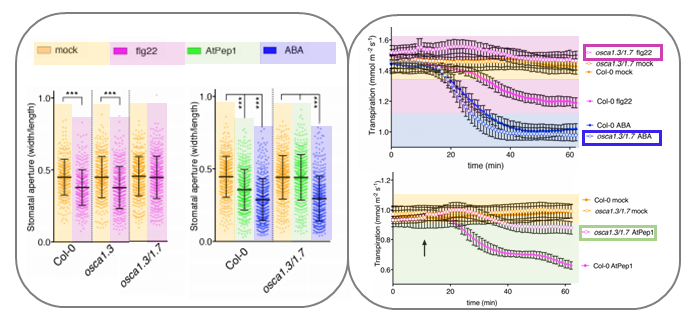 In plants, the perception of environmental threats induces a peak of calcium ions (Ca2+) in the cytosol that triggers signal transduction pathways leading to stomatal closure as defense response. In Arabidopsis, the mechanosensitive Ca2+ channel OSCA1 regulates water transpiration in response to abiotic stress, yet, a similar Ca2+channel involved in plant response to pathogens has not been identified. In this article, Thor and coworkers discovered that OSCA1.3, an uncharacterized isoform localized to the plasma membrane, is essential for plant immunity. Upon treatment with elicitors (i.e., pathogen- and damage- associated molecular patterns, PAMPs and DAMPs), the plasma membrane-associated cytosolic kinase BIK1 activates OSCA1.3 by directly phosphorylating its first cytoplasmic loop. Furthermore, electrophysiological experiments revealed that OSCA1.3 facilitates Ca2+ transport, as its expression in multiple heterologous systems correlates with an increase in cytosolic Ca2+. The authors also observed that the loss of function mutations of OSCA1.3 and the related gene OSCA1.7 associates with reduced Ca2+ spiking in guard cells, and consequently impairment of stomatal closure after treatment with elicitors (flagellin22 and AtPep1) but not with the abiotic stress hormone ABA. To summarize, Ca2+ channels play essential roles in the regulation of stomata functioning to guarantee gas exchange for optimal photosynthesis as well as prompt response to abiotic and biotic stresses. Specifically, OSCA1 and OSCA1.3/OSCA1.7 control stomata closing to reduce water loss and to restrict pathogen entry, respectively. (Summary and image adaptation by Michela Osnato @michela_osnato) Nature 10.1038/s41586-020-2702-1
In plants, the perception of environmental threats induces a peak of calcium ions (Ca2+) in the cytosol that triggers signal transduction pathways leading to stomatal closure as defense response. In Arabidopsis, the mechanosensitive Ca2+ channel OSCA1 regulates water transpiration in response to abiotic stress, yet, a similar Ca2+channel involved in plant response to pathogens has not been identified. In this article, Thor and coworkers discovered that OSCA1.3, an uncharacterized isoform localized to the plasma membrane, is essential for plant immunity. Upon treatment with elicitors (i.e., pathogen- and damage- associated molecular patterns, PAMPs and DAMPs), the plasma membrane-associated cytosolic kinase BIK1 activates OSCA1.3 by directly phosphorylating its first cytoplasmic loop. Furthermore, electrophysiological experiments revealed that OSCA1.3 facilitates Ca2+ transport, as its expression in multiple heterologous systems correlates with an increase in cytosolic Ca2+. The authors also observed that the loss of function mutations of OSCA1.3 and the related gene OSCA1.7 associates with reduced Ca2+ spiking in guard cells, and consequently impairment of stomatal closure after treatment with elicitors (flagellin22 and AtPep1) but not with the abiotic stress hormone ABA. To summarize, Ca2+ channels play essential roles in the regulation of stomata functioning to guarantee gas exchange for optimal photosynthesis as well as prompt response to abiotic and biotic stresses. Specifically, OSCA1 and OSCA1.3/OSCA1.7 control stomata closing to reduce water loss and to restrict pathogen entry, respectively. (Summary and image adaptation by Michela Osnato @michela_osnato) Nature 10.1038/s41586-020-2702-1
The process of seed maturation is influenced by mechanical constraints
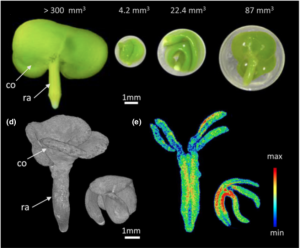 Developing organs need to sense their surroundings to modulate their growth. In the case of embryos, their development is physically limited by the embryo sac; thus, they must assess the space they have available for growing and modulate their growth accordingly. In this paper, Rolletschek et al. report for the first time first that embryos can adjust their expansion and metabolite storage in response to space restrictions both in planta and in vitro. Seeds grown in constricted siliques had smaller embryos but with higher protein and lipid content. Moreover, the analysis of labeled 13C-sucrose and 15N-glutamine revealed that embryos of constricted siliques had a lowered nutrient uptake. By growing excised embryos in chambers of varying volumes, the authors found that this response in size reduction and metabolite deposition was not only proportional to available space for growing but relatively free of maternal influence. Even if the exact mechanism that triggers this response is yet to be described, this study provides evidence that embryos can modulate their growth and metabolism in response to the space available for their development. (Summary by Carlos A. Ordóñez-Parra @caordonezparra) New Phytol. 10.1111/nph.16815
Developing organs need to sense their surroundings to modulate their growth. In the case of embryos, their development is physically limited by the embryo sac; thus, they must assess the space they have available for growing and modulate their growth accordingly. In this paper, Rolletschek et al. report for the first time first that embryos can adjust their expansion and metabolite storage in response to space restrictions both in planta and in vitro. Seeds grown in constricted siliques had smaller embryos but with higher protein and lipid content. Moreover, the analysis of labeled 13C-sucrose and 15N-glutamine revealed that embryos of constricted siliques had a lowered nutrient uptake. By growing excised embryos in chambers of varying volumes, the authors found that this response in size reduction and metabolite deposition was not only proportional to available space for growing but relatively free of maternal influence. Even if the exact mechanism that triggers this response is yet to be described, this study provides evidence that embryos can modulate their growth and metabolism in response to the space available for their development. (Summary by Carlos A. Ordóñez-Parra @caordonezparra) New Phytol. 10.1111/nph.16815


